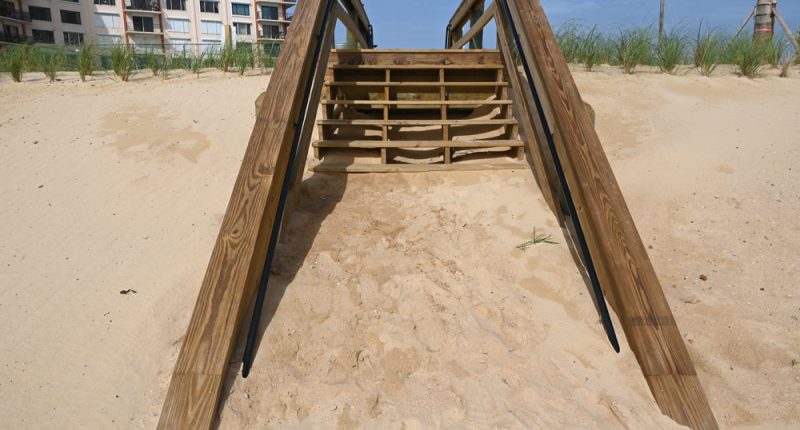
Flagler County commissioners agree that the county’s beach-management plan must include all 18 miles of beach, and do not dispute its $120 million cost over the next six years. As accomplishments, that was no small thing today for the issue that has most vexed and divided the commission’s five members.
But with three commissioners still opposed to increasing the county sales tax, a funding plan remains elusive. Without it, the rest is moot as a viable beach well into the future.
With one exception, no new revenue source emerged as the “alternative” two commissioners continue to say is out there, if only the county administration crunched the number, other than the re-calculating of existing numbers. The exception is the possible addition of a flat barrier island property surtax the administration estimates at over $900 per parcel, on every parcel. Barrier island residents are as likely and as sharply to oppose it as when a version of it–and a far smaller fee–was proposed countywide last year, when Palm Coast and Flagler Beach immediately killed it.
A four-hour meeting of the commission today did not resolve that impasse. It did not foreclose on a solution, either. As at a high-stakes summit riven by seemingly unbridgeable differences, the commissioners at least agreed to continue exploring options even if it means collating a list of revenue sources for a year or two, until a more solid plan can be devised. But there was little question that today’s workshop ended with still more uncertainty, and that it was not where any of the commissioners wanted to end.
“I don’t know what the headline is going to be after today,” Commission Chair Andy Dance said, reflecting the We’re we’re still not decided on a on a way forward with funding, we are going to need some additional non half cent scenarios,
Ansley Wren Key, the coastal engineer in charge of Flagler County’s beach management, summarized the revenue sources for the commissioners–from the Tourist Development sales surtax, from the general fund, from special taxing districts, from the sales tax. Commissioner Kim Carney had shared an American Shore and Beach Preservation Association white paper that also included parking fees and bonds as potential revenue sources. Key herself found that counties with similar characteristics as Flagler’s have a combination of tourism and special taxing districts to fund their plans.
The summary underscored an essential point: state and federal grants are available, but depend on a commitment by Flagler County to have dollars of its own from reliable revenue to contribute.
Dance repeated that point, warning against any plan that would be more “smoke and mirrors” than a true commitment by Flagler County. “We get the most money out of this through our federal and state partners, and by having a defensible plan,” he said. “If we’re trying to make some type of mirror game with funding, they’re going to see right through it in a heartbeat, and they are going to know that it is not viable. So the most important thing we can do is, no matter how we fund it, it has to be defensible.”
The county has cobbled together many of those sources, with federal and state dollars accounting for the lionshare of needed revenue, and the local share drawing from tourism tax revenue, the general fund. For all that, there remains a $17.5 million shortfall just to rebuild the coastline. Beyond that, the county has an annual $10 million shortfall just to maintain the beaches and ensure that they can be renourished every six years.
“To ensure that long-term sustainability of beach preservation,” County Administrator Heidi Petito said, “it is critical to identify some additional recurring local revenue sources that will provide a stable, predictable funding stream for future nourishment.”
Petito spoke of the current budget facing a $2.9 million deficit. If the deficit were to be “absorbed” by the county and the five constitutional officers, she said, it would equate to a 10 percent cut in the budget. If it were to be absorbed by the county alone, it would be a 20 percent cut.
But Petito’s figures seemed outlandish: the proposed county budget is $83.4 million. A $2.9 million cut is 3.5 percent to its budget, not 20 percent, and it would be a 1.9 percent cut to the combined $150 million budgets of the constitutional officers and the county, not 10 percent. Petito’s 10 and 20 percent figures are closer to accuracy if what she meant was a combination of closing the deficit and funding the beach-management plan’s deficit through cuts to other parts of the budget.
Commissioners did not challenge Petito’s numbers, though Dance at one point relied on them to say, “Lord, help us if you’re trying to make me go negotiate with the sheriff on a 10 percent budget cut, or any of the other constitutionals.”
The point was that cutting government services to fund the beach is not a viable plan, as Commissioner Greg Hansen put it. “The only answer, the only solid answer to this, is to create a new stream of money,” Hansen said. “There’s only two ways to do that. You can do the half-cent sales tax, or you can increase your ad valorem taxes,” meaning the property tax. Otherwise, the budget would have to be robbed. He said even the white paper Carney submitted pointed to the half-sent sales tax.
As Hansen spoke, Carney gathered her things and was ready to walk out but for Dance keeping her from leaving. “This is the making of the sausage. This is not fun. It is not pleasant, but has to be done,” Dance said. “If we leave and abandon this, we are not solving a problem.”
Carney said the belief that the half-cent sales tax is the only way to solve the funding issue is incorrect. She said the half-cent sales tax proposal is “one part of it.” She is right. It is one part among several. But to the county administration–and to Hansen and Dance–it is an essential, or at least irreplaceable, part. Without it, there would be no plan.
Carney disagrees. She presented a plan of her own. “I believe this is fluid,” she said. “I do not believe that we need $20 million in the bank by 2026 in order for the state to talk to Flagler County. I don’t believe that.” She proposed the following: increasing tourism tax dollar revenue, increasing the property tax revenue dedicated to the beach, drawing from a Municipal service taxing unit (or MSTU), and carrying over $5 million from the current year’s unused funds.
She also mentioned a “deal” with the state transportation department to “sustain our sea walls.” The state had previously committed $500,000 annually. It’s not clear what it will commit to now, with two sea walls. But whatever it commits, Carney was mixing apples and oranges: sand for the sea walls stops at the dune line. The transportation department will not pay for sands on the beach itself. Carney’s total was $8.5 million in 2026 “just to get us started,” and without a sales tax increase.
Dance wasn’t close to being convinced, especially with Carney’s suggestion of an MSTU in addition to another fee that property owners would pay. Based on that approach, Deputy County Administrator Jorge Salinas said, the taxing district would have to charge $905 per parcel, in addition to a $160 fee the county was planning to charge property owners as part of a different funding stream.
“I don’t know that we’ve come up with additional clarification on staff to be able to come up with a non-half penny funding formula,” Dance said. “We have plenty of buckets that we can pull from, but there needs to be clarification on the extent of the buckets.”
Commissioners agreed to fold that discussion into their July 2 budget workshop, when they will have their own general fund spreadsheets in front of them.
Notably during public comments, Suzanne Johnston, the former tax collector, and Jay Gardner, the property appraiser, spoke and both opposed any taxing scheme that would, in their view, unfairly burden barrier island residents. Both said the sales tax was the fairer approach. “You have to do something. But with the sales tax, I have a choice,” Johnston said. “You have a choice on how much you pay. You can eat out and pay sales tax, cook at home and not pay sales tax.”
“I came here with high hopes,” a west-side resident told the commissioners. “We were going to have all kinds of new numbers, new figures, new ideas. But it looks like we got the same stuff again, different font, a little bit different layout. But again, we’re being told this half-cent tax is the only way to go.”
Most others, in words ranging from forbearing to encouraging to hectoring, urged commissioners to keep working toward a comprehensive plan ensuring the future of the county’s 18 miles of shore. “Coming out of this meeting,” Maroon Manley said, “I think the headline should be: ‘Beach Plan Going Forward,’ and go on from there and add your adjectives.”
It is, but along foggy, unpredictable shoals.









